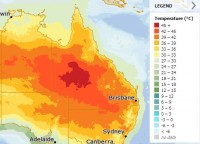Prolonged Severe to Extreme heatwave conditions to continue this week
12/02/2018

Prolonged Severe to Extreme heatwave conditions are forecast to continue throughout this week for large parts of Queensland, including heavily populated areas along the coastal strip.
Ipswich and Rockhampton will see persistent temperatures in the high 30s, while locations further inland like Emerald and Longreach will see even higher temperatures in the low-to-mid 40s.
This is the most significant and widespread heatwave to affect Queensland this summer, with temperatures recorded so far up to 11 degrees above the February average.
Sunday saw a number of locations record temperatures well above the February average: Stanthorpe 36.6C (11C above average) with Toowoomba 38.4C, Warwick 39.2C and Roma 42.7C (10C above average).
The Bureau defines a heatwave as three or more days in a row when both day-time and night-time temperatures are unusually high in relation to the local long-term climate average for that location.
Hot days with cooler nights allow for some recovery, but if the temperature stays high overnight then the maximum temperature will be reached earlier in the following day and last longer. When unusually high night and daytime temperatures persist, heat stress becomes a critical factor in human survival and infrastructure resilience.
Queensland Health encouraged those in affected areas to plan ahead and take the necessary precautions to stay safe against heat-related illnesses.
“Heat-related illness can be incredibly serious and even life-threatening, which is why it’s important to take the necessary precautions and know the warning signs,” a Queensland Health spokesperson said.
“Symptoms can vary from person to person, but if someone you know if exhibiting symptoms such as an elevated body temperature, flushed dry skin, a rapid pulse, headache, disorientation or loss of consciousness, they might be suffering from a heat-related illnesses and you should call Triple Zero (000) immediately.”
- Drinking plenty of fluids, preferably cool water, regularly throughout the day – don’t wait until you’re thirsty
- Staying indoors when possible, preferably in a building with air-conditioning or good air flow
- Limiting strenuous outdoor activity and taking time to adjust to the temperature
- Staying cool by taking cool showers, soaking feet in water or wearing a wet bandana or washer around your neck, and
- Checking the colour of your urine to ensure you are well-hydrated – it should be clear to light straw-coloured, not dark or gold.
For further information on how to stay safe during a heatwave.
Low-intensity heatwaves are the most common—most people are able to cope with this level of heat.
Severe heatwaves are less frequent and are challenging for vulnerable people such as the elderly—particularly those with pre-existing medical conditions.
Extreme heatwaves are the rarest kind. They affect the reliability of infrastructure, like power and transport, and are dangerous for anyone who does not take precautions to keep cool—even those who are healthy. People who work or exercise outdoors are particularly at risk.
For the latest three-day heatwave outlook see our Heatwave Service.
To view the temperature forecast in your local area see our graphical weather forecast, MetEye.










